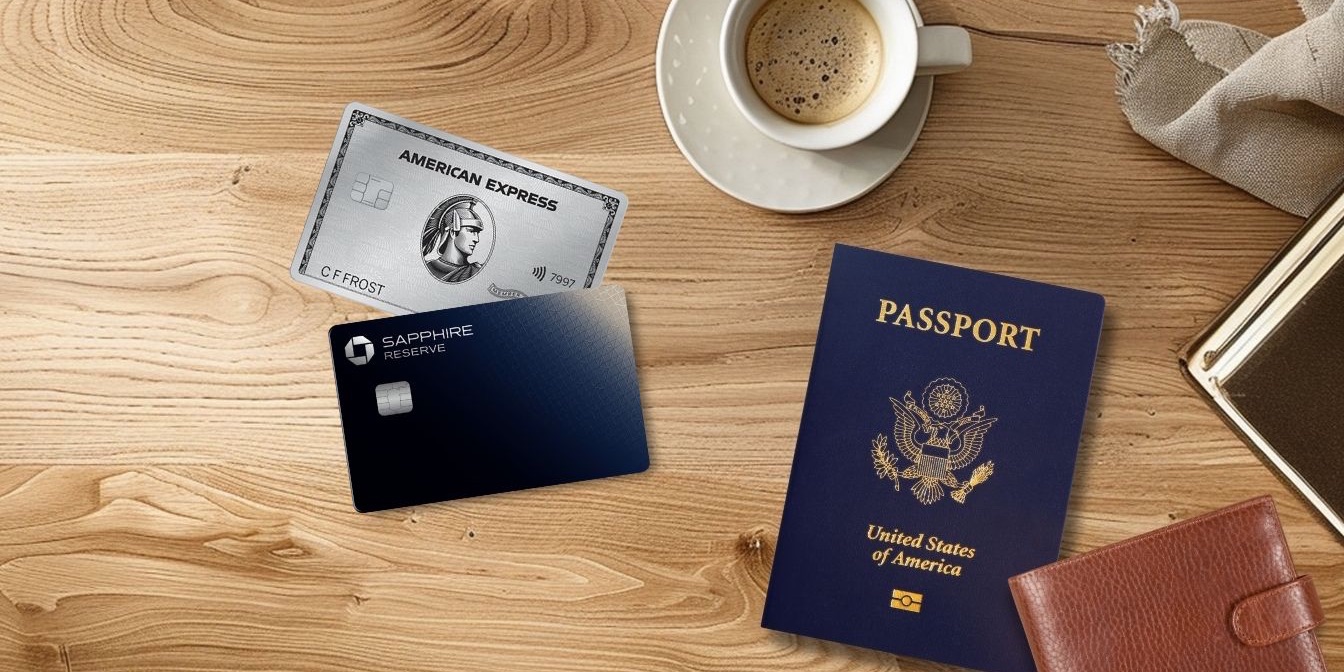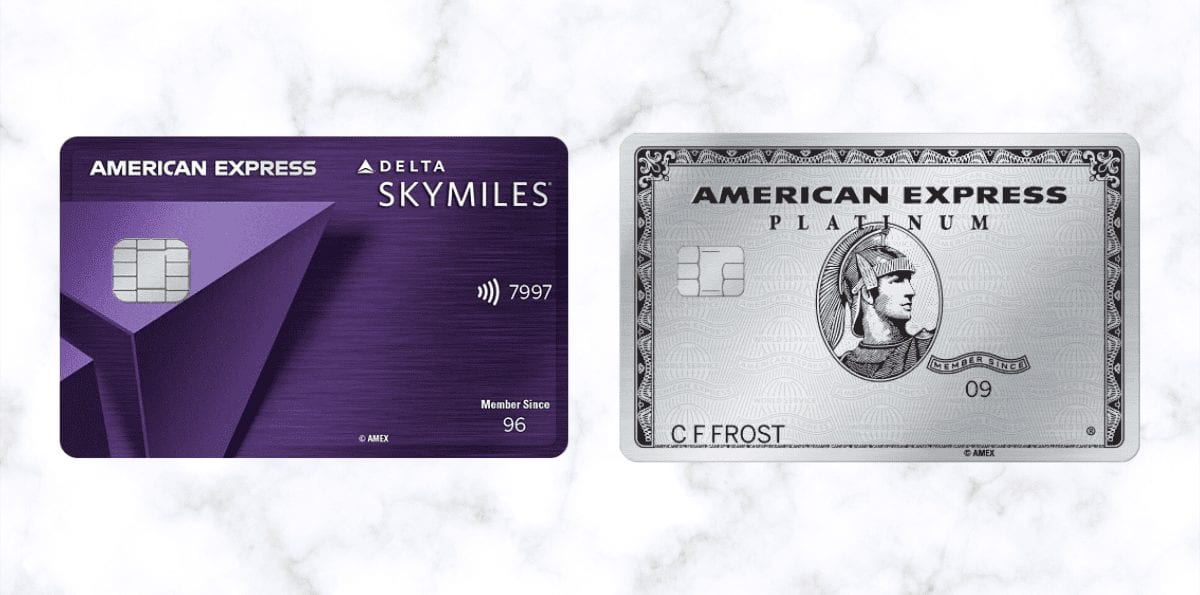There are dozens of cards out there to accelerate your travels, but two stand out from the rest of the pack: *amex platinum* and the *csr*.
These aren’t introductory cards for the average Joe or Jane, but rather powerful weapons for frequent travelers. And while the hefty annual fees may scare some off, they come with top-of-the-line perks that could easily justify the higher out-of-pocket cost.
After recent overhauls on both the Chase Sapphire Reserve and Amex Platinum, it's time to put these two titans of travel rewards back under the microscope. Which card comes out on top? Which premium perks win out?
We'll break it all down, category by category, for travelers to decide which premium travel credit card suits them best.
Comparing Welcome Offers
Getting a big pool of points for signing up might be reason enough for many to consider applying for one of these cards. And we can't blame you for that – there's no better way to jumpstart your points and miles travel fund than by capitalizing on a huge welcome offer.
Both of these cards provide a bonus that's worth going after, but one can certainly be more lucrative than the other.
Amex Platinum
bonus_miles_full
Chase Sapphire Reserve
bonus_miles_full
Which Offer is Best?
With Chase, what you see is what you get. But with Amex, you'll have to submit your application before you see what offer (if any) you're targeted for.
No matter how you slice it, these are both great offers that can easily offset the annual fee in year one and beyond. But if you are targeted for the biggest possible welcome offer on the Platinum Card, it's hard to beat.
Learn more about *amex platinum*.
Annual Fee
Let’s get the sticker shock out of the way first: With either of these cards, you'll be paying nearly $800 or even $900 a year in annual fees.
But just like you can't judge a book by its cover, you shouldn't judge either of these cards solely based on their annual fee. It's what's on the inside – earning points, getting travel benefits, and potentially useful money-saving credits – that truly counts.
Amex Platinum
If you opt for the Amex Platinum Card, you'll be on the hook for a annual_fees annual fee (see rates & fees) each year. That's no small sum of money and one that could scare off many travelers considering a new card.
But with that high annual fee comes over $3,500 in statement credits available each and every year. While virtually no one should value those credits at full value, but even if you only use three of them, you'll cover the card's annual fee … and then some.
Chase Sapphire Reserve
With the Chase Sapphire Reserve, you'll need to pony up annual_fees each year of card membership.
But like the Amex Platinum, the Sapphire Reserve now comes with a slew of statement credits, totaling more than $2,700 in value – Chase's words, not mine. Considering the card still includes its hallmark $300-per-year travel credit and other useful perks, you can still get your money's worth back out of that high fee fairly easily.
Which Card Wins on Fees?
There's no denying that the Chase Sapphire Reserve is the (slightly) more economical option among these two cards. However, given the higher-value credits and relative ease of use, the Amex Platinum is likely the better investment for most.
That said, in terms of upfront, out-of-pocket costs, the Sapphire Reserve has the edge here.
Learn more about the *csr*.
Earning Points
Of course, those big bonuses are alluring, but both of these cards offer ways to earn more points on your ongoing spending.
Here's what you can expect to earn with one of these cards in your wallet.
Amex Platinum
With the Amex Platinum Card, you'll earn 5x points per dollar spent (on up to $500,000 per year) on airfare directly with any airline, or through American Express Travel®. You'll also earn 5x points per dollar spent on prepaid hotels booked through Amex Travel.
You'll earn 1x points per dollar spent on all other purchases.
Because you can earn 5x points per dollar spent on airfare booked directly with the airline or through Amex Travel, we think the Platinum Card is the best option for booking flights.
Related reading: The Biggest Mistake You're Making With Your Amex Platinum Card
Chase Sapphire Reserve
With the Chase Sapphire Reserve, you'll earn 3x points per dollar spent on dining at restaurants worldwide (including takeout).
You'll also earn 4x points per dollar spent on flights and hotels booked directly, and you'll earn 8x points per dollar spent on any Chase Travel bookings. It's worth noting that the first $300 spent on travel purchases annually will be covered by Chase's flexible travel credit (more on this in a bit) and won't earn any points.
Finally, you'll earn 5x points per dollar spent on Lyft rides – but only through Sept. 30, 2027.
All other purchases earn 1x points per dollar spent.
Which Card is Better for Earning Points?
The fact that you can earn extra points on more purchases gives Chase’s top card a narrow win here. But that could easily flip if you’re frequently buying flights.
Learn more about the *csr*.
Airline & Hotel Transfer Partners
Both of these cards earn transferable points, allowing you to send them directly to a dozen or more airline and hotel programs. While it might feel daunting at first, it's the key to getting more value out of your points.
But the list of options varies between the two banks. Here's what each card and program has to offer.
The Chase Sapphire Reserve®
Chase is a titan in the travel rewards industry, and that’s due in large part to some excellent transfer partners.
Ultimate Rewards points will transfer at a 1:1 ratio to all programs. That means one Chase Ultimate Reward point equals one hotel point or airline mile.
| Program | Type | Transfer Ratio | Transfer Time |
|---|---|---|---|
| Aer Lingus | Airline | 1:1 | Instant |
| Air Canada Aeroplan | Airline | 1:1 | Instant |
| Air France/KLM | Airline | 1:1 | Instant |
| British Airways | Airline | 1:1 | Instant |
| Iberia Plus | Airline | 1:1 | Instant |
| JetBlue | Airline | 1:1 | Instant |
| Singapore Air | Airline | 1:1 | 12-24 hours |
| Southwest Airlines | Airline | 1:1 | Instant |
| United Airlines | Airline | 1:1 | Instant |
| Virgin Atlantic | Airline | 1:1 | Instant |
| World of Hyatt | Hotel | 1:1 | Instant |
| IHG | Hotel | 1:1 | 1 day |
| Marriott Rewards | Hotel | 1:1 | 2 days |
Read up on Chase transfer partners, including how to transfer your points and which options here are best!
The American Express Platinum Card®
American Express currently has 20 different airline and hotel partners – including some really valuable standout options.
While that flexibility and easy earning opportunities make Membership Rewards points a must for any frequent traveler, there are a few downsides to keep in mind.
First, American Express charges a very small fee (.06 cents per point) on transfers to domestic airlines. So if you transfer 100,000 points to Delta or JetBlue, you’ll get charged $60. These fees are capped at $99.
Here’s the full list:
| Program | Type | Transfer Ratio | Transfer Time |
|---|---|---|---|
| Aer Lingus | Airline | 1:1 | N/A |
| AeroMexico | Airline | 1:1.6 | 2-12 days |
| Air Canada Aeroplan | Airline | 1:1 | Instant |
| Air France/KLM | Airline | 1:1 | Instant |
| ANA | Airline | 1:1 | 1-2 days |
| Avianca | Airline | 1:1 | Instant |
| British Airways | Airline | 1:1 | Instant |
| Cathay Pacific | Airline | 1:1 | Instant |
| Delta | Airline | 1:1 | Instant |
| Emirates | Airline | 1,000:800 | Instant |
| Etihad | Airline | 1:1 | Instant |
| Iberia | Airline | 1:1 | 1-3 days |
| JetBlue | Airline | 1.25:1 | Instant |
| Qantas | Airline | 1:1 | Instant |
| Qatar Airways | Airline | 1:1 | Instant |
| Singapore | Airline | 1:1 | Instant |
| Virgin Atlantic | Airline | 1:1 | Instant |
| Choice Privileges | Hotel | 1:1 | Instant |
| Hilton Honors | Hotel | 1:2 | Instant |
| Marriott Bonvoy | Hotel | 1:1 | Instant |
And unlike Chase, there are a few transfer partners like JetBlue, Emirates, and Hilton to which your points won’t transfer on a 1:1 basis.
Read our full guide to Amex transfer partners, how they work, and how to get the most out of them!
Which Points Program is Best for Transfers?
The answer to this question largely depends on which partners you will use the most.
As you can see, there is a significant overlap between the programs. For example, you can transfer points from both banks to Air Canada Aeroplan, Singapore Airlines, Virgin Atlantic, and more.
Because Chase points transfer to all its partners on a 1:1 basis, including World of Hyatt – arguably the most valuable hotel loyalty program in the world – Chase ekes out a win here.
Learn more about the *csr*.
Lounge Access
When it comes to making your next trip or long layover better, nothing goes further than having airport lounge access.
At the very least, you’ll find comfortable seating with a place to charge your phone, high-speed Wi-Fi, and free food and drinks. Some lounges take it to the next level with over-the-top amenities and great design.
While there are many ways to get airport lounge access, the easiest way boils down to what’s in your wallet: Both of these cards can get you into thousands of airport lounges (and counting).
The American Express Platinum Card®
The Platinum Card is without question the top dog of travel cards when it comes to complimentary airport lounge access. No card will get you into more airport lounges than the Amex Platinum Card, period.
For starters, there's American Express' signature Centurion® Lounges. With 30-plus locations around the U.S. and abroad, these lounges have set the bar high … though, they've fallen off some in recent years. Platinum cardholders get unlimited complimentary access for themselves, but no free guests … unless you spend $75,000 per year on your card.
Each and every Centurion Lounge offers a full buffet, complimentary beer, wine, and cocktails, as well as spa services in select locations. There’s comfortable seating, power outlets, quiet spaces to work, and more.
Read more: Master Guide to Amex Centurion Lounges: Locations, Access & More

If you frequently travel through any airport with a Centurion Lounge, the Platinum Card can be a slam dunk for that reason alone. Check out our YouTube video review of the Centurion Lounge in Denver (DEN).
Like many other premium travel cards, the Platinum Card also offers a Priority Pass™ Select membership. You'll get unlimited visits to these locations and can bring in two guests with you for free.
Next, if you often fly Delta, the Platinum Card might just be the best card for you. Just for holding the card, you'll get complimentary access to any Delta Sky Club® (10 visits per year, between Feb. 1 – Jan. 31), so long as you are flying Delta. However, bringing a guest with you comes with an added fee: You can pay for up to two guests for $50 each.
Read more: How to Access the Delta Sky Club®

Finally, in addition to the top-notch lounges above, the Amex Global Lounge Collection will get you into a handful of other smaller lounge networks.
The Escape Lounge – Centurion Studio Partner lounge network is solid – in fact, the Minneapolis-St. Paul (MSP) location is a great alternative to the Delta Sky Club. Like Priority Pass lounges, you will be able to bring up to two guests with you on each visit free of charge.

The Chase Sapphire Reserve®
The Sapphire Reserve is your ticket into the growing list of Chase Sapphire-branded lounges. Over the last couple years, Chase has been playing catch-up with American Express and lapping Capital One with its network of lounges … and they've caught up fast.
These aren't your average, run-of-the-mill airport lounges, either. Chase has upped the ante with each new lounge it debuts: The designs are all chic and spacious, the complimentary food and drinks are a big step above your typical airport club, and many feature upscale amenities like showers and wellness areas.
Chase Sapphire Reserve cardholders get complimentary access for themselves and two guests at all of Chase's Sapphire Lounge locations.
The card also comes with a complimentary Priority Pass Select membership, which gives you free access to an additional thousand-plus airport lounges around the world. You can also bring up to two guests into these lounges for free.

Priority Pass lounges can be a bit of a mixed bag: Some are great, while others are fairly lackluster. But no matter what, it's a better place to relax before your flight than the terminal, grabbing a quick snack or a drink for free.
Read More: Chase is Winning the Airport Lounge Wars … & It's Not Close
Which Card is Best for Lounge Access?
There's no question that the Platinum Card opens the most lounge doors. As Chase works to build out a network of its own lounges, that calculus could change. But right now, this is an easy choice.
Learn more about *amex platinum*.
Travel & Other Statement Credit Credits
Both of these premium travel cards offer statement credits for different stores, retailers, and services that can drastically offset the out-of-pocket expense you'll pay to hold either card.
Some are easier to use than others. But no matter which card you carry, using these credits is the key to making the annual fee math work.
Let's take a look at what each card offers.
The American Express Platinum Card®
American Express has spent the last few years (close to a decade, really) pioneering the “coupon book” model that's now spread to nearly every premium travel card on the market. While we were at a breaking point earlier this year, the card's most recent refresh has shifted the tide and against all odds, made the nearly $900 card a mainstream lifestyle status symbol.
Seriously: This card offers so many different credits each year, keeping track of them feels like a full-time job. In fact, we've recently designed a spreadsheet to do just that.
But using these credits is the key to justifying the Platinum Card's hefty annual fee. Here's a list of the credits the card offers:
- Up to a $200 Airline Incidental Fee Credit: Each year you hold the Platinum Card, you get up to a $200 credit to use with one U.S. airline of your choice. The credit is intended to be used for incidental fees like checked bags, change or cancellation fees, seat assignments, lounge access, and more, but there are some workarounds you can use to put that credit toward covering airfare instead. Check out our guide on how to maximize Amex airline fee credits!
- Up to a $600 Hotel Credit: Get up to $300 semi-annually for prepaid hotel bookings through the Amex Travel booking portal. This credit only applies to Fine Hotels + Resorts® or Hotel Collection properties, which include some great resorts and hotels around the globe. Notably, stays at Hotel Collection properties require a minimum stay of two consecutive nights.
- Up to a $400 Annual Resy Credit: Platinum cardholders now get up to $100 in statement credits each quarter (for up to $400 each year) for dining purchases at more than 10,000 U.S. Resy-partner restaurants.
- Up to a $300 Lululemon Credit: Cardholders can now get up to $75 back each quarter (up to $300 a year) on purchases at U.S. Lululemon retail stores (excluding outlets) or online at lululemon.com.
- Up to $200 of Annual Uber Cash: Each year you hold the Platinum Card, you get up to $200 toward Uber Cash. You get $15 each month, and $35 in the month of December (for $200 total annually).
- $120 Uber One Credit: Cardholders can now get up to $120 back each year when they use their Platinum to cover the entire cost of an Uber One membership
- Up to $300 Digital Entertainment Credit: Cardholders can get up to $300 in annual statement credits for select entertainment services, with monthly installments of $25. But this benefit is incredibly restrictive: It currently only applies to purchases or subscriptions with Disney+, The Disney+ Bundle, ESPN+, Hulu, Peacock, The New York Times, the Wall Street Journal, Paramount+, YouTube TV, and YouTube Premium.
- Up to $100 Annual Credit for Saks Fifth Avenue: Each year of card membership, you will get two $50 credits to be used at Saks Fifth Avenue stores. One $50 credit is available from January through June, with another available from July through December.
- Up to $300 Equinox Credit
- Up to a $200 Oura Ring Credit: Platinum cardmembers can now get up to $200 back each year toward a purchase at Ouraring.com, including the sleek Oura Ring wearable that’s become a favorite for fitness and wellness tracking.
- Credit for Global Entry or TSA PreCheck®: Like every other card on this list, there's also a credit of up to $120 to cover the cost of either TSA PreCheck or Global Entry on the Platinum Card.
- A $209 Credit for CLEAR® Plus: Platinum cardholders get a $209 annual credit for the privately run security program. Just pay for your membership with your Platinum Card and the credit should kick in automatically.
- Monthly Walmart+ Credit: Cardholders receive a $12.95 monthly credit to cover the cost of Walmart+, the retail giant's response to Amazon Prime with free shipping, same-day local delivery, and discounts at the gas pump. This also includes a Paramount+ membership.
The Chase Sapphire Reserve®
Just for holding the Chase Sapphire Reserve, you'll get an annual $300 travel credit.
This annual travel credit is one of the most lucrative benefits of any travel credit card … and it's also one of the easiest to use. With that $300 travel credit, you can essentially think of the Sapphire Reserve's annual fee as being $495 a year.
Any purchase that Chase considers travel will qualify for the $300 annual travel credit on the Chase Sapphire Reserve. And that covers a lot of ground, including many expenses you might not normally consider “travel,” like tolls, public transit, and parking fees. For a full list of purchases that Chase will code as travel, visit the FAQs on Chase's credit cards rewards page.
In addition to the $300 annual statement credit, Chase Sapphire Reserve cardholders also get the following statement credits:
- Up to a $120 credit for Global Entry, TSA PreCheck®, or NEXUS every four years stays.
- Up to $500 in annual hotel credits for 1,100-plus properties in Chase Travel's “The Edit” portfolio with additional benefits like a $100 onsite credit, complimentary breakfast for two, space-available upgrades, and more
- Split into two, $250 credits available from January through June and again from July through December. Must book at least a two-night stay
- Up to a $300 annual dining credit at select “Sapphire Reserve Dining” restaurants bookable through OpenTable
- Split into two, $150 credits available from January through June and again from July through December
- Complimentary subscriptions to Apple TV+ and Apple Music – up to a $250 value
- Up to a $300 annual StubHub credit for concert and event tickets
- Split into two, $150 credits available from January 1 through June 30, and again from July 1 through December 31 for purchases on StubHub.com and viagogo.com. Activation required.
- Up to $120 in Peloton credits annually towards memberships, split into $10 monthly allotments
- Cardholders will still earn 10x points on Peloton equipment and accessories
- Up to $120 in Lyft credits annually, split into $10 monthly allotments
- Up to $300 for DoorDash annually, including two up to $10 monthly discounts toward non-restaurant orders, up to $5 a month off restaurant orders, and a complimentary DashPass membership
Which Card has the Best Statement Credits?
While the Amex Platinum offers a ton in terms of potential dollar value, some of these credits require a lot of effort to use … and others have questionable value in the first place. Still, most travelers shouldn't have to work too hard to recoup their annual fee and come out ahead. For that reason, it easily takes this category.
Learn more about *amex platinum*.
Travel Insurance
I'll cut to the chase (pun intended): This category isn't much of a competition. The Sapphire Reserve isn't just the better of these two cards for travel protections … it might be the best card, period.
It starts with offering up to $100 a day if your baggage is delayed by six hours or more. Its trip delay and cancellation coverage are second-to-none, reimbursing you for associated expenses of any delay of six hours or more – so long as you pay for your flight with the card. The Chase Sapphire Reserve also offers primary car rental insurance and even provides coverage for injuries during a trip that was paid at least in part with the card – including medical evacuation.
American Express offers some trip delay and interruption coverage – long a weak spot for the card. Unfortunately, it requires round-trip bookings to be put on the card for this coverage to kick in – a quirk you won't find with the Sapphire Reserve. Additionally, the Platinum card's car rental coverage isn't quite as good (it's secondary) … nor is its lost luggage reimbursement.
Which Card Provides the Best Travel Insurance?
If it wasn't clear from the outset, the Chase Sapphire Reserve offers unbeatable travel insurance. Even with some enhancements to the coverage offered by the Amex Platinum, it just can't compete with all the insurance offered by Chase.
Learn more about the *csr*.
Bottom Line
By the numbers, the Chase Sapphire Reserve wins four of these categories, while the Platinum Card takes the other three. But the scoreboard doesn't tell the whole story.
The Platinum Card is best for perks like lounge access and elite status … and despite its higher fee, may actually be the better value overall. Meanwhile the Sapphire Reserve edges ahead on earning points and comes with some of the best travel protections of any card.
Choosing the winner here depends on your travel style, and every traveler should weigh the pros and cons of both these cards before deciding which to open.







Can you be more specific about the $300 travel credit with The Chase Sapphire Reserve? Do you charge the travel, etc to that card and then apply the credit toward the charges? Thank you.
Any travel expense charged to your Chase Sapphire Reserve card will automatically trigger the credit. Read more here: https://thriftytraveler.com/guides/credit-card/chase-sapphire-reserve-travel-credit/
If you have both cards, which card would you put your flights on? One gives you better points per flight and one gives you better insurance.
Hi Linda, I would personally use the Platinum card for flights. You’ll earn 5x points per dollar and you will still get very good insurance coverage.